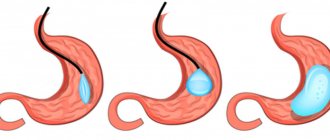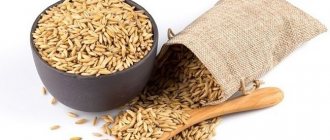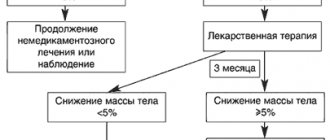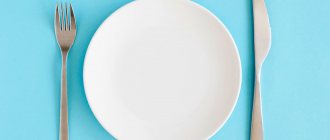By contacting the Medical Center on Mamina-Sibiryaka 45, you will receive professional help in getting rid of food addiction - a special emotional attachment to eating sweet and fatty foods, as well as products with taste enhancers and flavoring additives.
If you notice that:
- Food begins to “control” you;
- You increasingly “eat up” stressful situations;
- The joy of life is associated only with certain products;
- Chocolate, ice cream, chips, sausage and other “goodies” add extra pounds to you
You should definitely contact the Medical Center on Mamina-Sibiryaka 45 in Yekaterinburg and undergo treatment for food addiction at a low price!
We are waiting for you for a free consultation every Tuesday from 15:00 to 17:00!
In what cases of food addiction should you consult a doctor?
The significant severity of psychological food addiction is evidenced by:
- Inability to stop once you start eating: the planned two pieces of chocolate easily and imperceptibly turn into a whole bar with a cupcake on top.
- Obsessive thoughts about food: fatigue, sadness, sadness, boredom and other negative emotions, you simply “eat.”
- The desire to eat certain foods: most often we are talking about candy, cookies and other sweets, somewhat less often - fast food, chips, seeds.
- Evening gluttons: an incorrect diet has already affected your metabolism, changing the amount of enzymes and hormones produced at different times of the day. Due to the increased appetite, it is almost impossible to control evening breakdowns.
- Emotional disorder: Eating disorders are always followed by psychological problems - dissatisfaction with one's appearance, increasing feelings of guilt and causeless anxiety.
- Breakdowns: With food addiction, the battle takes place simultaneously on two fronts - with excess weight and your own addiction to junk food. In such conditions there is simply not enough strength, and breakdowns are inevitable.
- Reason: as a rule, the next attack occurs during feasts. Especially if there is alcohol on the table.
A team of qualified medical psychotherapeutic specialists will help you cope with harmful addictions! The MC specializes in solving problems associated with overweight and obesity, as well as gambling addiction, tobacco smoking, and alcoholism.
All doctors working in the clinic have significant professional experience. It includes both psychotherapeutic and general medical activities. However, specialists regularly improve their skills by participating in various conferences and seminars, and undergoing training in thematic cycles. The result of such self-development is the introduction of new medical achievements into practice.
Let's talk about each area of treatment in more detail. So, every woman wants to have not only beauty, but also grace, lightness, elegance. But sometimes such a dream can be difficult to fulfill due to the fact that the fairer sex suffers from excess weight. As a result, her self-esteem decreases and depression may occur. Another serious aspect of the problem is the development of diseases against the background of obesity that can harm the entire body. They affect the digestive and endocrine systems, spine and joints. You can effectively get rid of this problem by using the Smelov method for treating obesity. This is emotional stress therapy. Accordingly, the coding of the patient’s consciousness occurs at the psycho-emotional level. After a treatment session, a person begins to experience an improvement in both his physical and emotional state. After some time, weight loss occurs.
The clinic also performs coding for gambling addiction. This problem is now relevant for many. People of all ages are susceptible to addiction, but among young people there are still more gamblers. There are people who need coding for smoking or coding for alcoholism, because they themselves are not able to stop their cravings for nicotine and alcoholic beverages. All this leads to problems in the family and at work, loss of trust in the addict, psychological and physical illnesses. Read articles on our website, study the best offers for yourself, and seek help from doctors. You can and should get rid of bad habits that significantly complicate your life! Cravings can be blocked using a special “psychological code.” The doctor puts it on during the session. But it is possible to get an effective result only when the addict sincerely wants to be cured.
It should be represented in many cities of Ukraine and Russia. At the center you will find progressive treatment methods and competent specialists. They are always ready to help their patients. Get treatment and regain your health. Give yourself a chance for a new life!
How does the psychophysiological programming method work?
The process of treating food addiction in Yekaterinburg includes several successive stages:
- Freeing yourself from “cravings” for foods that you were previously emotionally dependent on. This effect becomes noticeable after the first session. And just 2-3 days after it, the sense of smell and taste for natural food returns.
- Restoring emotional balance: magnetic laser (reflex therapy) eliminates anxiety and improves sleep quality. At the same time, obsessions about harmful foods go away - psychological food addiction is destroyed.
- Stopping “evening gluttons”: after a short time, carbohydrate metabolism will normalize, and you will no longer feel hungry in the evenings.
- Weight loss: the glands that produce hormones responsible for burning fat are activated. Weight loss occurs naturally, without stress to the body.
Treatment of other eating disorders
In addition to taking a food addiction coding course, our clinic will help patients cope with the following eating disorders:
- Alcohol and food addiction, in which the mood on weekdays depends on the upcoming consumption of alcohol “with a good snack” on the weekend.
- Dependence on sweet and fatty foods, the effects of which resemble the effects of drugs on the body: the absence of such foods causes a depressive state, which goes away when they are consumed.
- Compulsive overeating. It can be described by the phrase “I can’t stop eating until there is severe discomfort in my stomach.”
- Bulimia nervosa, which involves alternating periods of uncontrolled overeating and forced purging of food through medication or vomiting.
The price list shows prices for treatment of food addiction and other types of eating disorders.
It is carried out using the method of neurophysiological programming. | 20,000 rub. |
The path to a new life. Treatment of obesity at CNMT
According to the Russian Academy of Medical Sciences, today in Russia 60% of women and 50% of men over 30 years of age are overweight, and 30% of them are obese. Excess weight not only spoils the figure and has a bad effect on well-being, it entails serious diseases - diabetes, metabolic syndrome, diseases of the joints and spine. Unfortunately, when excess weight exceeds 30 kg, it becomes difficult for a person to cope with the problem alone. Obesity of the second and third degrees is more often treated surgically, since physical activity is not recommended with such an amount of excess weight. CNMT has several programs for the treatment of obesity, which include teamwork of different specialists, as well as surgical treatment methods.
What is obesity and why is it dangerous?
Obesity is a chronic disease characterized by excessive accumulation of adipose tissue in the body. The cause of the development of obesity may be endocrine, hypothalamic disorders, sharp limitation of physical activity without correction of habitual diet. But most often, the cause of obesity is systematic overeating.
Obesity and overweight are not only an aesthetic problem. The accumulation of fat mass in the body is a risk factor for many serious diseases of the cardiovascular system, type 2 diabetes, liver and gallbladder diseases, musculoskeletal system and others. These diseases occur in obesity 6-9 times more often than in people of the same sex and age who are not overweight.
The life expectancy of obese patients is 10-12 years shorter than that of their peers with normal body weight. The more fat accumulates in the body, the more pronounced metabolic disorders are, and the more often associated diseases are observed.
We would like to immediately warn you against trying to get rid of extra pounds with the help of diets that are so generously offered by the online community. Many of them are not only useless, but also harmful and can lead to deterioration in overall health.
How obesity is treated at CNMT
Our Center has a number of programs for patients who want to lose weight. The best treatment strategy for obesity will be selected for you, depending on the cause of its occurrence and severity. The composition of the treatment program will be influenced by age, degree of development of the disease, state of health, and the presence of concomitant disorders.
Treatment necessarily includes a consultation with a nutritionist who will draw up an individual balanced nutrition plan, taking into account gender, age, and professional activity; will tell you what products to choose and how to prepare tasty and healthy food. The doctor will also assess how many kilograms the patient can actually lose weight and determine whether there are any contraindications to weight loss.
Based on the test results, a geneticist will determine how your body will react to various foods and physical activity, so he will be able to give an informed answer about the correctness of the chosen method of losing weight.
Based on the results of laboratory and functional diagnostics, specialists will determine whether weight gain is associated with endocrine and other diseases. In this case, you will be prescribed effective treatment that will help you lose and maintain weight. Courses of massage, vacuum therapy, acupuncture and physical therapy will help you tighten your skin, relax and relieve stress.
If you are diagnosed with obesity, and not just overweight, then you will be consulted by a surgeon who will help you choose a surgical treatment method. It will be your assistant in weight loss and will give impetus to further lifestyle changes.
Surgical treatment of obesity
Obesity is a chronic disease that has become a major health problem in most industrialized countries. Morbid (or morbid) obesity has acquired truly alarming proportions due to the inevitable development of severe concomitant diseases that are in a direct cause-and-effect relationship with excess body weight. Treatment begins with diagnosing obesity and determining its degree using the Body Mass Index (BMI).
Classification of obesity by BMI (WHO, 1997)
Body mass index (BMI) is a measure of a person's height and weight that is designed to determine whether a person is underweight, normal, or overweight. To calculate it, take your weight in kilograms and divide it by the square of your height in meters. For example, the BMI for a girl with a height of 170 cm (1.7 m) and a weight of 54 kg would be 18.69.
What does BMI show?
- Less than 16 – anorexia
- 16 – 18.5 – mass deficit
- 18.5 – 25 – normal
- 25 – 30 – presence of excess weight
- 30-35 – stage 1 obesity
- 35 – 40 – stage 2 obesity
- 40 or more - stage 3, or morbid obesity.
It is important to know that this index is not suitable for assessing the body weight of people with developed muscles (athletes, bodybuilders), people under 20 years of age or over 65 years of age, pregnant and lactating women.
From a surgical point of view, patients with a body mass index of 25-30 should be treated conservatively, that is, without surgery.
- With a BMI between 30 and 40, conservative treatment can be combined with the installation of an intragastric balloon.
- For BMIs between 35 and 40, conservative treatment is used in combination with an intragastric balloon, and surgical treatment may be indicated. It is prescribed if there is a disease associated with excess weight, and you can expect an improvement in the course of this disease after losing weight (diabetes mellitus, arterial hypertension, joint pathology, etc.).
- When a BMI is more than 40, surgical intervention is advisable: gastric sleeve, gastric bypass.
- For BMI over 50, surgical treatment is indicated: gastric bypass, small intestinal bypass, biliopancreatic bypass.
More details about the methods
- Installation of an intragastric balloon (BMI 30-40) is not an operation in the usual sense; rather, it is an outpatient procedure that resembles FGS (fibrogastroscopy). A balloon is placed in the stomach, which is filled with air or liquid and reduces the capacity of the stomach. The balloon is installed for an average of 6-18 months, after which fibrogastroscopy is performed, during which it is emptied and removed. This treatment method is completely reversible.
- Installation of an adjustable gastric band (BMI 35-50). The bandage is a special silicone ring that is placed on the stomach to divide it into two unequal parts - upper and lower. At the moment of eating, the smaller upper part of the stomach is filled and a signal is sent to the brain that the body is full. Thus, to satisfy a person, a much smaller amount of food is enough than he is used to. The advantage of this operation is that it is performed laparoscopically. The disadvantage of this method is the need to thoroughly chew any food to avoid large pieces of food getting stuck in a narrow area of the stomach. This treatment method is conditionally reversible.
- Sleeve gastrectomy (partial gastrectomy, Sleeve Gastrectomy, vertical gastrectomy, longitudinal gastrectomy), BMI 35-50 – removal of part of the stomach. It leads to a limitation in the amount of food a person consumes. The essence of the operation is to remove most of the stomach and create a small tube-shaped stomach. After surgery, a person can eat almost any food, but in small quantities. Sleeve gastroplasty is part of a program aimed at reducing body weight, since if the patient continues to consume large amounts of food after such an operation, there is a possibility of “stretching” the gastric tube and even its rupture with life-threatening consequences.
- Gastric bypass (BMI 40-50) combines two mechanisms: malabsorption (decreased absorption of nutrients) and reduction in stomach volume. Most of the stomach is removed, and the remainder is sutured to the ileum, and the severed small intestine is sutured into the distal ileum. Thus, in addition to shrinking the stomach, food begins to pass by the part of the small intestine where maximum absorption of nutrients occurs. This operation is performed laparoscopically, it is widely used in Western countries and allows patients to get rid of 70-90% of excess body weight. This type of operation is accompanied by the least number of complications compared to other operations aimed at disrupting the absorption of nutrients.
- Biliopancreatic bypass is a large, lengthy and complex bariatric surgery that effectively reduces excess weight. It is not used very often, as it may be accompanied by certain complications. It has been experimentally established that approximately 150 minutes of physical activity per week is sufficient to achieve excellent results in weight loss after gastric bypass surgery. We recommend that patients after bypass surgery strive for regular physical activity, gradually increasing and complicating the load. Physical education is needed to reduce the risk of developing cardiovascular diseases and increase the endurance of the cardiopulmonary system, increase muscle strength and tone, and improve well-being and mood.
After operation
It happens that after losing weight quickly or losing tens of kilograms, his skin may sag a lot. This can cause discomfort, irritation, tearing, pain and infection, not to mention aesthetic problems. This situation can be solved with the help of special plastic surgeries aimed at removing excess skin and subcutaneous fat in the right places. Plastic surgeries may include abdominoplasty (tummy tuck), thigh, buttock and breast lift, torsoplasty, lipectomy, brachioplasty, face and neck lift, and liposuction.
Surgical treatment of obesity is only the first stage of work. At the same time, a person learns to eat differently, move more and enjoy a new life. After the operation, you will need some time for rehabilitation, which can also be completed at our Center: physiotherapy, exercise therapy, massage, lymphatic drainage and pressotherapy - all this will help you recover faster after the operation and get used to a new lifestyle.
We wish you success in the difficult struggle with extra pounds! Remember that we are always ready to help.









